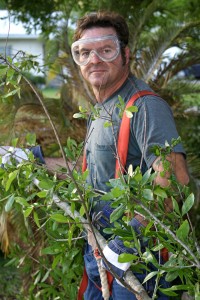
How to Secure & Restore Your Lawn After Hurricanes
As the winds die down after a hurricane, and the skies clear, the mess, unfortunately, remains behind. Flooding, downed branches, and power outages delay life’s return back to normal. In some cases, a collapsed limb requires emergency tree removal. What requires immediate attention and what requires an experienced professional?
Here are ways to help your lawn recover after a large storm, like this recent hurricane.
Cleaning Up Your Landscape After Storms.
Make sure your environment is safe to begin clean-up. Look for downed power lines, debris hanging on power lines, or large puddles of standing water. Allow professionals to deal with these circumstances before beginning your clean-up process.
1. Inspect the trees on your Property
Fallen or unstable trees are one of the top safety risks following a storm. Look at all of the trees on your property for signs of damage, such as broken tree top or fallen branches. If you see these signs of severe tree damage on your property, call an Orlando tree service to determine what the appropriate next steps would be.
Accuweather estimates that Hurricane Irma caused approximately $100 billion in damages, including property damage from downed trees. Proper assessment of your property can minimize your personal damage cost, after the storm.
2. Use a rope to section off larger portions of trees.

If you are having trouble cutting or removing a larger tree (or afraid of it falling and damaging the surrounding property) handle it and sections. First, tie a rope around the section you are cutting away from. This will be the section you expect to fall FIRST. Have a friend hold onto the rope carefully while you cut. Then, let that section fall slowly, in a controlled manner. Do the same with the remaining sections. The slower you go, the better. Only cut sections you are comfortable holding until they fall to the ground. Knowing the basics of emergency tree removal can reduce the overall damage to your property.
3.Pick up small branches
 While small yard debris is not as hazardous as downed or damaged trees, it can be unsightly and problematic when life returns to normal. Research yard waste collection options in your neighborhood. Many cities will collect yard debris and turn it into wood chips. Excess leaves can be turned into compost and worked into the soil.When removing the small debris, wear gloves to protect yourself from insects, glass, or other hazards that may be strewn through the yard.
While small yard debris is not as hazardous as downed or damaged trees, it can be unsightly and problematic when life returns to normal. Research yard waste collection options in your neighborhood. Many cities will collect yard debris and turn it into wood chips. Excess leaves can be turned into compost and worked into the soil.When removing the small debris, wear gloves to protect yourself from insects, glass, or other hazards that may be strewn through the yard.
4.Care for Damaged Plants
While your garden may have taken a severe beating from the storm, inspect each plant to see if it is salvageable. If the stems are still intact, remove the damaged leaves, up to one-third of the plant. If your plants happened to be uprooted, attempt to replant and prune. With just a bit of gentle care, your plants should be able to regrow what they lost.
5.Remove destroyed plants
Plants with damage to their stems are not likely to recover. After clearing the immediate debris, take the time to remove and replace the destroyed plants.Consult a landscape design company for tips on storm-friendly plants to replace the destroyed ones.

6.Note Areas of Flooding
If the same few areas of your yard flood after every storm, consider adding new plants, such as shrubs or trees in the area. These plants can help absorb some of the excess water, cutting down on your risk of flooding after a major storm. If the dip in the yard is visible, consider hiring a landscape company to fill and even out that spot in your yard.
7.Care for Your Trees
While many, many trees did not survive the storm, there are plenty that did. Be prepared for the next major storm by taking extra care of the trees in your lawn. Many routine lawn service tasks such as mulching, fertilizing, and watering can help keep your trees healthy. A healthy tree is less likely to have branches snap off during a major storm.
While Hurricane Irma did cause significant damage to homes and lawns across Central Florida and beyond, emergency tree removal will not be difficult to obtain. Daniel’s Lawn Service is ready to help you with downed trees, bush hogging, and other lawn care services.



The term “survival kit” may possibly also refer to the larger, portable survival kits prepared by survivalists , referred to as “bug-out bags” (BOBs), “Personal Emergency Relocation Kits” (PERKs) or “get out of Dodge” (Very good) kits, which are packed into backpacks, or even duffel bags. These kits are designed specifically to be more easily carried by the person in case alternate types of transportation are unavailable or impossible to use.
Thanks for this great article. I agree it’s so important for home owners to be cautious when dealing with tree damage after a major storm.